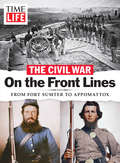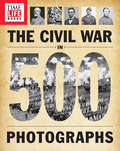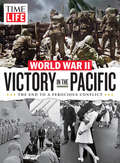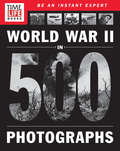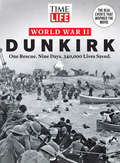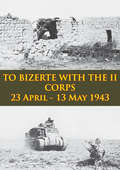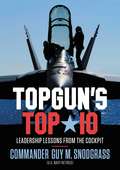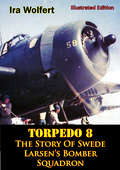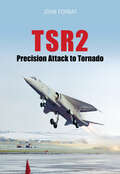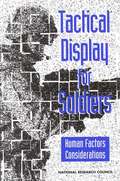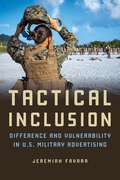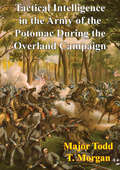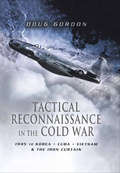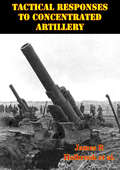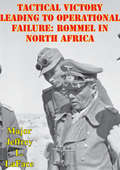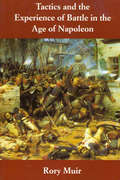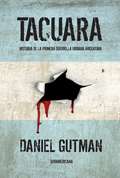- Table View
- List View
TIME-LIFE The Civil War - On the Front Lines: From Fort Sumter to Appomattox
by The Editors of TIME-LIFENorth vs. South. Brother against brother. The War of Northern Aggression. The Civil War, over 150 years in our nation's past, still weighs upon American culture and politics to this day. Now, in an all-new special edition, TIME LIFE brings readers a thorough overview of what remains the largest, longest and most bloody war set on American soil in The Civil War, On the Front Lines: From Fort Sumter to Appomattox.Written in the trademark style of TIME LIFE that marries compelling photography and illustration to thoughtful yet accessible text and graphics, The Civil War, On the Front Lines covers every facet of the war from the political and cultural divides that sparked the war, to life on the front lines for soldiers, slavery, and the war at home, to a country, once again united and transformed. Whether you're a Civil War buff or just in search of a little more information, The Civil War, On the Front Lines will bring you a thorough overview of the war that has continued to affect America.
TIME-LIFE The Civil War in 500 Photographs
by Time-Life BooksThe name TIME-LIFE has become synonymous with providing readers with a deeper understanding of subjects and world events that matter to us all. TIME-LIFE The Civil War in 500 Photographs is an indispensable guide to a nation-changing era and the military, social, economic, and political forces that shaped it.TIME-LIFE The Civil War in 500 Photographs provides a fresh and accessible way to understand this conflict including details of the battles and battlefields, the political maneuverings, and the personalities who defined the war continue to fascinate citizens of all ages. It lays out the war's major developments in arresting, colorized images and cover topics from the backstory through secession, the Union's early setbacks, the Underground Railroad, victories at Gettysburg and Vicksburg, and Reconstruction.For history buffs and the newly curious, The Civil War in 500 Photographs is the ultimate, easy-to-use guide to four years that changed our nation forever.
TIME-LIFE Victory in the Pacific: The End to a Ferocious Conflict
by The Editors of TIME-LIFEAs 1945 progressed, Allied forces continued to move from island to island across the Pacific, closing in on the Japanese homeland. In Victory in the Pacific, youÍll find the winning strategies that lead to the Allies retaking Manila, invading Okinawa, attacking Iwo Jima and, finally, dropping the atomic bomb on Hiroshima and Nagasaki. The Japanese could fight no more. After six long years, World War II was truly over.
TIME-LIFE World War II in 500 Photographs
by Time-Life BooksWorld War II, fought from 1939 to 1945, engulfed the globe in a shattering struggle over national sovereignty and individual rights. It was also the costliest battle in history in terms of human life, with millions perishing in combat, in concentration camps, and under the rubble of crushed cities. This gripping and epic battle is brought powerfully to life on every page of Time-Life Books' World War II in 500 Photographs. From the Nazis' early rise to power to Victory over Japan Day, this essential guide brings you to the front lines of the war that changed our world.
TIME-LIFE World War II: One Rescue. Nine Days. 340,000 Lives Saved.
by The Editors of TIME-LIFEDiscover the heroes who saved 340,000 livesThe Battle of Dunkirk has come to represent heroic perseverance in the face of adversity. By May 1940, Hitler's Nazis had pushed the Allies into a corner of France, almost to the sea. They thought the English had no choice but to surrender . . . but they were wrong. "We shall fight on the beaches," said Winston Churchill, the new English prime minister, and fight they did. Surrounded by German ground forces and bombarded by Nazi warplanes, some 340,000 British and French troops were rescued by a makeshift flotilla of military and civilian ships despite incredible odds. Photographs from the archives of TIME and LIFE magazines, combined with compelling text, put the mission in historic context and show how this massive operation unfolded. Discover true heroism in Time-Life World War II: Dunkirk, a remarkable collector's keepsake.
TIME-LIFE World War II: The Final Victories
by Time-Life BooksThe name TIME-LIFE has become synonymous with providing readers with a deeper understanding of subjects and world events that matter to us all. Now, as the U.S. commemorates the 70th anniversary of the end of World War II, TIME-LIFE revisits the pivotal final battles and events in one of the most influential periods in history in World War II: 1945. Between January and August of 1945, the Allies staged their last great military victories, participated in the Potsdam and Yalta conferences, and mourned the death of FDR. Adolf Hitler committed suicide, Benito Mussolini was hanged. The first atomic bomb was dropped. These are just some of the events in the closing months of World War II, a dramatic period that both marked the end of the bloodiest conflict in history and laid the groundwork for the coming Cold War. Organized chronologically, World War II: 1945 maps out the conflict's end in a visual, easy-to-digest format that illustrates key events, days, battles, personalities, military strategies, political maneuverings and betrayals. A compelling, illustrated package, the book will bring 1945 to life for a public curious to learn about the year that changed the world.
TO BIZERTE WITH THE II CORPS - 23 April - 13 May 1943 [Illustrated Edition]
by AnonWith 18 maps & 24 Illustrations.A DELEGATION OF GERMAN OFFICERS arrived at American Headquarters south of Ferryville at 0926 on 9 May 1943. Their mission was to surrender the remnants of a once proud unit of the Wehrmacht, the formidable Fifth Panzer Army...Marshal Giovanni Messe, commanding the Italian First Army, surrendered unconditionally to the British Eighth Army on 13 May. The long battle for North Africa was ended.Troops of the II Corps, U. S. A., who had entered the fight for Africa with the invasion on 8 Nov. 1942, played a prominent role in the decisive final battle which opened on 23 April...Within 2 weeks of the Nov. landings in Northwest Africa, British and American forces under General Dwight D. Eisenhower were driving from Algeria into western Tunisia in an effort to seize the great ports of Tunis and Bizerte. German reinforcements, rushed into Africa in the nick of time, stopped the advance just short of the Tunis plain. With operations now made difficult by the rainy winter season, the Allied Army fought bitter engagements in the mountains from Sedjenane Station to Medjez el Bab. To the south, American units in hard fighting stopped savage German drives through Kasserine Pass toward the Allied base at Tebessa and kept pressure on the long Axis communications between Field Marshal Rommel and Tunis.In late March, Rommel's forces were driven from the Mareth Line toward the north. Protecting his line of retreat, the enemy fought a stubborn delaying action against the Americans and the British in the El Guettar-Gafsa area. By 22 April the equivalent of 5 Italian and 9 German divisions were at bay for what they planned to be a protracted defense of Tunis and Bizerte. But the Axis was not allowed a breathing space to strengthen its defenses. The Allied forces, united under General Sir Harold R. Alexander as the Eighteenth Army Group, were already preparing the blow that was to destroy the enemy forces in a battle lasting 21 days.
TOPGUN on Wall Street
by Patrick Robinson Lieutenant Commander Jeffery LayA revolutionary business approach by Lt. Col. Jeffery Lay and #1 "New York Times" bestselling author Patrick Robinson, describing one manOCOs journey from the cockpit of F-14 fighter bombers to the scandalous boardrooms on Wall Street and why military practices can help stabilize corporate America. "
TOPGUN on Wall Street
by Patrick Robinson Lieutenant Commander LayTOPGUN on Wall Street chronicles one man's extraordinary journey from the cornfields of Ohio, to the cockpit of an F-14, to the boardrooms on Wall Street. Lieutenant Commander Jeffery Lay and #1 New York Times bestselling author Patrick Robinson bring a provocative, ground-breaking voice to the business landscape with a revolutionary answer for stabilizing corporate America: business--the military way. As a TOPGUN fighter pilot, Lieutenant Commander Lay perfected a tried-and-true military technique: PLAN -BRIEF - EXECUTE -DEBRIEF However, when he retired from active duty in 2006 and went to work for a subsidiary of the ill-fated Lehman Brothers, he noticed that everything about the business world was different: less efficient, awash with excuses for failure, allowance of men with tricky morals to rise to the top, self-gain overshadowing teamwork, and a devastating lack of accountability. With such deeply rooted flaws, is corporate America doomed for perpetual failure? Answer: Not if we put admirals in charge and adopt the military's tight chain of command. This game-changing thesis is interwoven with Lieutenant Commander Lay's dramatic story, including his high-intensity strike fighter aircraft landings, never-before-written details of the United States Navy Fighter Weapons School (TOPGUN), and his heart-breaking, humbling, and inspirational battle with cancer at the peak of his military career. TOPGUN on Wall Street is written by a leader determined to show the business world that excellence is a choice and perfection is attainable.
TOPGUN on Wall Street: A Fighter Pilot's Unique Story--from an F-14 Tomcat to the Heart of American Business
by Patrick Robinson Jeffery LayTOPGUN on Wall Streetchronicles one man's extraordinary journey from the cornfields of Ohio, to the cockpit of an F-14, to the boardrooms on Wall Street. Lieutenant Commander Jeffery Lay and #1New York Timesbestselling author Patrick Robinson bring a provocative, ground-breaking voice to the business landscape with a revolutionary answer for stabilizing corporate America: business-the military way. As a TOPGUN fighter pilot, Lieutenant Commander Lay perfected a tried-and-true military technique: PLAN -BRIEF - EXECUTE -DEBRIEF However, when he retired from active duty in 2006 and went to work for a subsidiary of the ill-fated Lehman Brothers, he noticed that everything about the business world was different: less efficient, awash with excuses for failure, allowance of men with tricky morals to rise to the top, self-gain overshadowing teamwork, and a devastating lack of accountability. With such deeply rooted flaws, is corporate America doomed for perpetual failure? Answer: Not if we put admirals in charge and adopt the military's tight chain of command. This game-changing thesis is interwoven with Lieutenant Commander Lay's dramatic story, including his high-intensity strike fighter aircraft landings, never-before-written details of the United States Navy Fighter Weapons School (TOPGUN), and his heart-breaking, humbling, and inspirational battle with cancer at the peak of his military career. TOPGUN on Wall Streetis written by a leader determined to show the business world that excellence is a choice and perfection is attainable.
TOPGUN'S TOP 10: Leadership Lessons from the Cockpit
by Guy M SnodgrassLearn how to be a leader in your own life and career with expert advice from one of the Navy's elite TOPGUN instructors.During a twenty-year career in uniform, Guy Snodgrass became one of the most skilled fighter pilots in the U.S. Navy, commanding combat jets over some of the most dangerous war zones in the world -- and he did it all using the lessons he learned at the Navy's Fighter Weapons School (TOPGUN).The real-life inspiration for the blockbuster films Top Gun and Top Gun: Maverick, the U.S. Navy Fighter Weapons School trains the top one percent of our nation's fighter pilots. Over the course of twelve weeks, these pilots are drilled on aerial tactics, combat, and skills required to win in any organization. Ordinary people are transformed into world-class leaders. Pilots, like Commander Snodgrass, who remain on staff as TOPGUN instructors, are held to even higher and more demanding standards.In TOPGUN's Top 10, Commander Snodgrass distills some of the most important lessons he's learned and taught over the course of his career into a taut, engaging book for readers of all ages and experience levels. It's the perfect gift for anyone looking to change careers, excel in the workplace, or find their way in the world after college graduation. Smart, practical, and direct, Snodgrass's account of real TOPGUN experience will inspire a new generation of leaders.
TORPEDO 8 — The Story Of Swede Larsen’s Bomber Squadron [Illustrated Edition]
by Ira WolfertIncludes the Island War In The Pacific Illustration Pack - 152 maps, plans and photos.The epic story of the death and rebirth of the famous Torpedo Squadron 8, destroyed at the Battle of Midway and rose again to become a crack outfit under the leadership of "Swede" Larsen."THE JAPS WIPED OUT THE UNITED STATES NAVY Torpedo Squadron 8 in a few minutes at the Battle of Midway. The minutes were hot and rough. The squadron was like a raw egg thrown into an electric fan, and only three men came out of the action alive. One of these is no longer fit for combat duty. His nerves are gone. They became unstrung in those few minutes, and in the ten months since then he has not been able to get them working again normally, although he has been out on the line trying his best, refusing painfully to give up.So, when Torpedo 8 was wiped out on Thursday morning, June 4, 1942, in about the time it takes to stamp out a pile of ants, it looked to those of us on the outside as if torpedo bombing were about to become a lost art.But the Navy did not agree. Nor did Torpedo 8 agree. The Navy seemed to know without asking that Torpedo 8 would not feel this way, for, without being asked, Torpedo 8 was thrown directly from Midway into the Battle for the Solomons -- a series of engagements into which the Japs put about five times the naval strength they used at Midway, and much more naval strength than they used against the Malay Peninsula and Java.Torpedo 8 went into the battle with two veterans of Midway, plus remnants of the old squadron who had not got into the action there, and plus 'replacements,' as they are called. They did not, as the Japs do, blame their dead for having died. They wanted revenge for them. Up to Midway, the slogan of the squadron had been 'Attack.' On June 12, eight days after the holocaust at Midway, the squadron commander in an official squadron memorandum changed the slogan to: 'Attack-- and Vengeance!'"-Introduction
TSR2: Navigation and Weapon Delivery
by John ForbatIncluded are details on the ground-breaking navigation and attack system, its Cold War context, its requirements and the development of ATF (advanced terrain following), and in-depth analysis of automatic flight control systems, analogue and digital simulations at Weybridge and the reconnaissance pack for mapping enemy territory. It finishes with a look at the final throes of TSR2's cancellation by the Labour government in 1965.
Tactical Combat Casualty Care and Wound Treatment
by U.S. Department of DefenseMilitary surgeons must assume a leadership role in combat casualty care in circumstances that are far less than ideal. This handbook provides much of the information needed to tackle these issues and features state-of-the-art principles and practices of forward trauma surgery as used by military physicians in far flung locations around the globe. In this volume you’ll learn such integral skills as: * Tactical field care * Field dressing * Applying pressure dressing * Treating burns * Treating inhalation injuries * And more! Tactical Combat Casualty Care and Wound Treatment is the most trusted and up-to-date manual offered by the Department of Defense for military medical personnel in the field.
Tactical Defeat Or Strategic Victory: The Battle Of Wake Island, 8-23 December 1941
by Major Marlyn. R. PierceGiven the constrained environment the US Armed Forces operate in would it be possible or even strategically feasible to relieve a cut-off force. This study investigates this scenario by using the historical example of Wake Island.Wake Island is an insignificant strip of coral located in the central Pacific. However, it gained strategic significance during pre-war planning. From its location, Wake Island could dominate the sea-lanes through the central Pacific.After the beginning of hostilities in 1941, the Japanese attacked Wake Island by air for three days before attempting an amphibious assault on 11 December. Miraculously, the defenders repulsed the Japanese. The only time during the Pacific War that an invasion attempt was defeated. Humiliated by the defeat, the Japanese returned on 23 December with a larger force. The defenders, again, put up a stubborn defense but eventually were overwhelmed.After the defenders defeated the Japanese on 11 December, the Navy's senior leaders were forced to decide on the fate of the men on Wake Island. In the final analysis it was determined that the strategic loss of any of three aircraft carriers operating in the Pacific outweighed the tactical gain of relieving the beleaguered island.
Tactical Display for Soldiers: Human Factors Considerations
by Panel on Human Factors in the Design of Tactical Display Systems for the Individual SoldierThis book examines the human factors issues associated with the development, testing, and implementation of helmet-mounted display technology in the 21st Century Land Warrior System.Because the framework of analysis is soldier performance with the system in the full range of environments and missions, the book discusses both the military context and the characteristics of the infantry soldiers who will use the system. The major issues covered include the positive and negative effects of such a display on the local and global situation awareness of the individual soldier, an analysis of the visual and psychomotor factors associated with each design feature, design considerations for auditory displays, and physical sources of stress and the implications of the display for affecting the soldier's workload. The book proposes an innovative approach to research and testing based on a three-stage strategy that begins in the laboratory, moves to controlled field studies, and culminates in operational testing.
Tactical Force (Declan’s Defenders #5)
by Elle JamesTheir search for an assassin makes her the next target.Two attacks on DC staffer Anne Bellamy’s life are just the beginning of a terrorist threat from a group that aims to assassinate the US president. It’s all-out war for former elite Force Recon marine Jack Snow, who is tasked with keeping Anne alive. As his mission takes him undercover into Washington’s power circles, can he protect his country and the woman who’s become way more than just an asset to him?
Tactical Inclusion: Difference and Vulnerability in U.S. Military Advertising (Feminist Media Studies)
by Jeremiah FavaraThe revolution in military recruitment advertising to people of color and women played an essential role in making the US military one of the most diverse institutions in the United States. Starting at the dawn of the all-volunteer era, Jeremiah Favara illuminates the challenges at the heart of military inclusion by analyzing recruitment ads published in three commercial magazines: Sports Illustrated, Cosmopolitan, and Ebony. Favara draws on Black feminism, critical race theory, and queer of color critique to reveal how the military and advertisers affected change by deploying a set of strategies and practices called tactical inclusion. As Favara shows, tactical inclusion used representations of servicemembers in the new military to connect with people susceptible to recruiting efforts and rendered these new audiences vulnerable to, valuable to, and subject to state violence. Compelling and eye-opening, Tactical Inclusion combines original analysis with personal experience to chart advertising’s role in building the all-volunteer military.
Tactical Intelligence In The Army Of The Potomac During The Overland Campaign
by Major Todd T. MorganThis study examines how Lieutenant General Ulysses S. Grant and the Army of the Potomac used tactical intelligence during the Overland Campaign. Although Grant did not achieve his operational objective to defeat General Robert E. Lee in the field, tactical intelligence allowed him to continue the operational maneuver of the Army of the Potomac, which later contributed to the eventual defeat of Lee in April of 1865. The examination of tactical intelligence in the Army of the Potomac covers the period of 4 May to 12 June 1864. It encompasses campaign planning and preparation, as well as the battles of the Wilderness, Spotsylvania Court House, North Anna River, and Cold Harbor. The study combines a general contextual overview of the campaign and battles with a focused discussion and analysis of tactical intelligence collection and use. The study also includes background discussion of influences that contributed to the lack of intelligence functions in the War Department and the Union Army, the intelligence organizations that emerged in the Army of the Potomac, and description of the primary forms and methods of tactical intelligence collection used during the campaign.
Tactical Reconnaissance in the Cold War: 1945 to Korea, Cuba, Vietnam & the Iron Curtain (Pen And Sword Large Format Aviation Bks.)
by Doug GordonThe little-known stories of the United States Air Force pilots who flew alone and unarmed into enemy territory in a world under threat of nuclear war. Tactical Reconnaissance in the Cold War describes how the United States Air Force tactical reconnaissance units operated from the end of World War II until the 1970s. This was an immensely active period that also included major conflicts in Korea and Vietnam. It was also a period of rapid technological development in aircraft and photographic techniques. This highly-illustrated book includes chapters on: the post-war period in Europe and the East; the Korean Conflict and the role of the 67th TRW from 1950 to 1954; the role of the highly secret RF-86 missions over Red China and the Soviet Far East in the early to mid &’50s; the RB-57A missions out of Bitburg and Yokota flying clandestinely over the Soviet Union and the RF-100A missions that were flown over the Soviet Union from Turkey, Rhine-Main and Yokota; United States Air Forces in Europe; the Cuban Missile Crisis and the role of the RF-101 Voodoos and RB-66s.
Tactical Responses To Concentrated Artillery
by James R. Holbrook Michael E. DunnThe focus of this study is on how the armies of different nations countered the threat of massive concentrated artillery and/or other types of preparatory fires. Not all were successful, and the reasons for the success or failure of each army provides the contemporary military commander an opportunity to learn from his "predecessors" and benefit from their hard-learned lessons.
Tactical Victory Leading To Operational Failure: Rommel In North Africa
by Major Jeffrey L. LaFaceSince the end of the Cold War, the worldview is that the US is presently the only superpower. The expectation, within the Department of Defense and the world's other military institutions, is that this status will exist for the next twenty years or until the year 2020. Even as the world's only superpower, the U. military has adopted a formal approach to joint and coalition warfare as the methodology to fight future military conflicts. This is for two reasons. The first reason is to gain world and national political consensus and legitimacy for any operation requiring the use of US military forces. The second reason is even the military resources of the US are limited and we must conduct military operations as part of a joint coalition force in order to reach our and the coalition's political endstate.This monograph asks the question: Can tactical victories guarantee the accomplishment of the coalition's operational aim? This monograph will use the example of the Afrika Korps in North Africa to answer this question. The purpose of the monograph is to show the outcome when a more militarily capable member of a coalition dictates the conduct of military operations. This consideration is relevant to the US Army due to our superpower status and our military capabilities relative to the rest of the world's military organizations. The monograph will show that Rommel's reliance on the tactical level of war and his lack of an operational understanding of what he was attempting to accomplish lead to their defeat in North Africa. Rommel's conducted tactical operations because he was not trained for or capable of conducting operational art. Because of this, he failed to support the strategic and operational aims of the political and military leadership. He lacked the cognitive creativity and therefore, the tension to support his government. Rommel's opportunism led to many victories on the battlefield but ultimately had an adverse effect on the Axis war effort.
Tactics and the Experience of Battle in the Age of Napoleon
by Rory MuirThis historical study of Napoleonic battles and tactics examines firsthand accounts from soldiers&’ memoirs, diaries, and letters: &“A major work&” (David Seymour, Military Illustrated). In this illuminating volume, historian Rory Muir explores what actually happened in battle during the Napoleonic Wars, putting special focus on how the participants&’ feelings and reactions influenced the outcome. Looking at the immediate dynamics of combat, Muir sheds new light on how Napoleon&’s tactics worked. This analysis is enhanced with vivid accounts of those who were there—the frightened foot soldier, the general in command, the young cavalry officer whose boils made it impossible to ride, and the smartly dressed aide-de-camp, tripped up by his voluminous pantaloons. Muir considers the interaction of artillery, infantry, and cavalry; the role of the general, subordinate commanders, staff officers, and aides; morale, esprit de corps, soldiers&’ attitudes toward death and feelings about the enemy; the plight of the wounded; the difficulty of surrendering; and the way victories were finally decided. He discusses the mechanics of musketry, artillery, and cavalry charges and shows how they influenced the morale, discipline, and resolution of the opposing armies. "Muir has filled an important gap in the study of the Napoleonic era."—Library Journal
Tacuara
by Daniel GutmanEl Movimiento Nacionalista Tacuara atrajo a comienzos de los años #60 a cientos de jóvenes que vieron allí una expresión de rebeldía contra el sistema. Nacido como un grupo anticomunista, antidemocrático y antisemita, desarrolló una capacidad para la acción violenta callejera que fue envidia de la propia Juventud Peronista. Sin embargo, la incorporación masiva de miembros con distintas visiones del mundo fue lo que sumió al movimiento en un complicado proceso de transformación. Así, mientras un sector afirmó su identidad, otro produjo una enorme conmoción cuando saltó a la escena como la primera guerrilla urbana de la historia argentina, con el cinematográfico asalto al Policlínico Bancario. Tacuara fue la escuela en la que convivieron y se formaron jóvenes que en los #70 serían líderes en las organizaciones guerrilleras, integrantes de los grupos de la derecha peronista, matones de los sindicatos y hasta agentes de inteligencia vinculados a la represión estatal. Esta segunda edición de Tacuara revisa la investigación que reveló el complejo proceso que llevó a aquellos compañeros de militancia juvenil a enfrentarse a la muerte. Es esencial no sólo para conocer la Argentina de los #60, sino también para entender la que llegaría poco tiempo después con el baño de sangre de los #70.
Taffy of Torpedo Junction
by Nell Wise WechterBack in print A longtime favorite of several generations of Tar Heels, Taffy of Torpedo Junction is the thrilling adventure story of thirteen-year-old Taffy Willis, who, with the help of her pony and dog, exposes a ring of Nazi spies operating from a secluded house on Hatteras Island, North Carolina, during World War II. For readers of all ages, the book brings to life the dramatic wartime events on the Outer Banks, where German U-boats turned an area around Cape Hatteras into 'Torpedo Junction' by sinking more than sixty American vessels in just a six-month period in 1942. Taffy has been enjoyed by young and old alike since it was first published in 1957.
